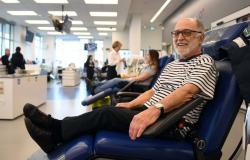Asthma attacks could be treated much better thanks to a British discovery. This is the first new treatment in 50 years for this lung condition which lands many patients in emergency rooms.
Posted at 8:04 p.m.
What is the British progress?
Using a drug called benralizumab for patients who arrive at the emergency room with an asthma attack or chronic pulmonary obstruction reduces relapses by 30%.
Benralizumab is also much less harmful than the current treatment, corticosteroids, says Richard Russell of Oxford University, one of the authors of the study published this week in the scientific journal Lancet Respiratory Medicine.
Consult the study published in The Lancet Respiratory Medicine (in English)
“Corticosteroids increase the risk of diabetes and osteoporosis and cause weight gain,” says Dr.r Russell. If you take it only five times, for five visits to the emergency room with a respiratory crisis, you arrive at the maximum recommended dose for your entire life. »
A specialist in asthma and chronic obstructive pulmonary disease (COPD) at the McGill University Health Center (MUHC), Jean Bourbeau describes the discovery as a “major breakthrough”. “We’ve been treating emergency room visits for asthma or COPD attacks the same way for 50 years. »
As benralizumab is already in use, its approval for these crises could occur within five years, according to Dr.r Russell. It is a “monoclonal antibody”, a “biological” treatment which targets cells of the immune system called eosinophils, involved in inflammation of the lungs.
What is the benefit for patients?
The treatment is more effective and reduces new hospitalizations, underlines the Dr Russell. “Benralizumab has very few negative side effects. »
On the other hand, it is necessary to check whether the dosage (three times higher than for current applications of benralizumab) will be as safe, he specifies.
But be careful, benralizumab will not help all patients. “It has to be a crisis involving eosinophils,” explains Dr.r Russell. This represents half of asthma attacks and 30% of COPD attacks. »
What are the current applications of benralizumab?
It has been used for around ten years to treat severe uncontrolled asthma. In this use, it is taken at regular intervals – in some cases, once every eight weeks – to prevent patients from having seizures.
The study’s lead author, Mona Bafadhel of Nuffield University, discovered 15 years ago that some patients have a type of asthma or COPD involving eosinophils. “So, we started to target eosinophils in the daily management of these diseases, to avoid attacks,” says Dr.r Russell.
But the few “biologic treatments,” such as benralizumab, used to treat “eosinophilic” asthma are very expensive, which prevents their widespread use, according to Dr.r Bourbeau. The cost of regular treatment can exceed $20,000 per year, he notes.
“It takes one to three months to have their use approved by the Régie de l’assurance santé du Québec [RAMQ] for an asthma patient”, maintains the Dr Bourbeau.
Biological treatments are not yet approved to manage severe COPD, to prevent attacks, but the Dr Bourbeau was able to prescribe it to a few patients in research protocols. “It changed their lives,” he said. We’re talking about people who were always out of breath, who are no longer out of breath. »
The Dr Bourbeau cannot provide statistics on the proportion of asthma patients who receive biological treatments. For his part, the Dr Russell estimates that 1.5% of British asthmatics receive them, but in an ideal world this proportion should be two to three times higher.
When will we see benralizumab used in the emergency room for asthma or COPD attacks?
If another clinical study confirms the results of Drs Russell and Bafadhel, the protocols will have to be changed. “Currently, patients in crisis often receive treatment before arriving in the emergency room, for example in a clinic,” explains Dr.r Bourbeau. We will need to find a way to identify eosinophilic attacks. In a context where blood tests are centralized, it will be difficult. »
The Dr Russell says a rapid blood test can detect within minutes whether a respiratory attack is of the eosinophilic type. “This test could even be done at home,” he says.
Another problem is that you will need to have benralizumab on hand, despite its cost. “Given the control we currently have over this drug, it will require an organizational change,” warns the Dr Bourbeau.
The Dr Russell, however, remains optimistic. “If we have fewer hospitalizations, it will be less expensive for the health system, even with these very expensive drugs. »
He mentions rheumatology, another medical field where diseases are caused by inflammation, and where biologic drugs are commonly used.
Learn more
-
- 10 %
- Proportion of the Canadian population who suffer from asthma
Source : Asthme Canada
- 9 %
- Proportion of the Canadian population suffering from chronic obstructive pulmonary disease
Source: Quebec Lung Association






